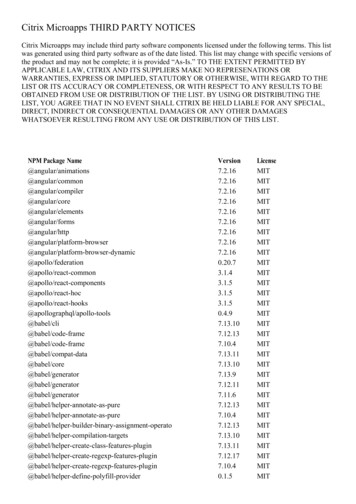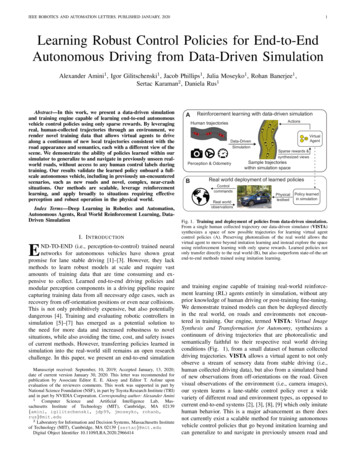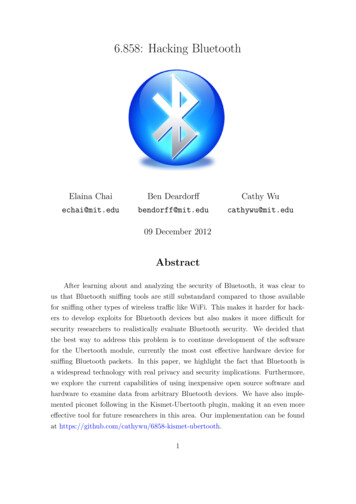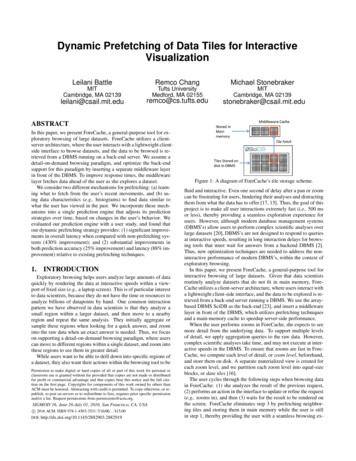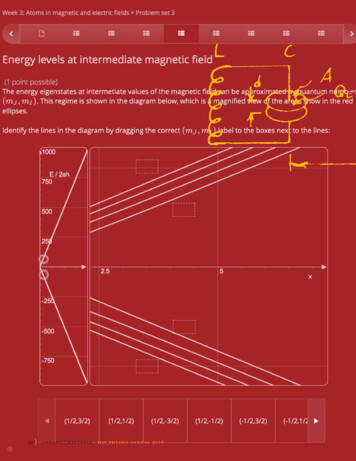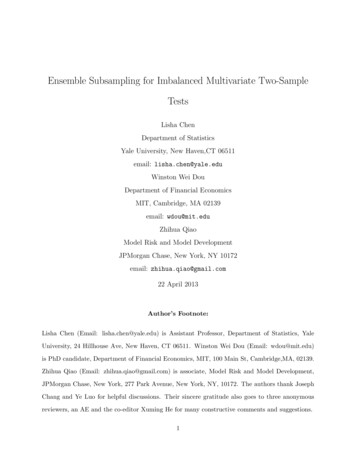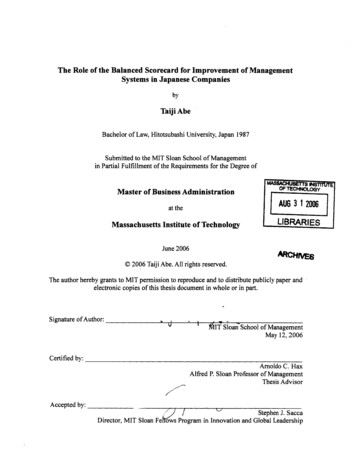
Transcription
The Role of the Balanced Scorecard for Improvement of ManagementSystems in Japanese CompaniesbyTaiji AbeBachelor of Law, Hitotsubashi University, Japan 1987Submitted to the MIT Sloan School of Managementin Partial Fulfillment of the Requirements for the Degree ofMAS-UcHUSMrrS SMaster of Business AdministrationOF TECHNOLOGYat theAUL 3 1 20E06sMassachusetts Institute of TechnologyLIBRARIESJune 2006ACHIVES 2006 Taiji Abe. All rights reserved.The author hereby grants to MIT permission to reproduce and to distribute publicly paper andelectronic copies of this thesis document in whole or in part.Signature ofAuthor:of Author:39rSloan School of ManagementIITSignatureMay 12, 2006Certified by:Amoldo C. HaxAlfred P. Sloan Professor of ManagementThesis Advisor/Accepted by:"ow /Stephen J. SaccaDirector, MIT Sloan Feows Program in Innovation and Global Leadership
The Role of the Balanced Scorecard for Improvement of ManagementSystems in Japanese CompaniesbyTaiji AbeSubmitted to the MIT Sloan School of Management on May 12, 2006in Partial Fulfillment of the Requirements for theDegree of Master of Business AdministrationABSTRACTThe concept of the Balanced Scorecard (BSC) was first developed by R. S. Kaplanand D. P. Norton in 1992 and since that time has been implemented in thousands oforganizations worldwide. While many tools that were proposed in the past tend to emphasizeonly one of values an organization has to realize, the Balanced Scorecard proposes that whatis the most important for an organization be to balance these values for discrete stakeholders,ultimately for improvement of corporate value.This thesis considers the role of the Balanced Scorecard (BSC) in solving issues facedby management in Japanese companies. During the period when BSC was introduced toJapanese organizations, most recognized the need to change their strategies in order toovercome the recession and to challenge emerging new competitors, When an organizationdecides to change its strategies dramatically, it needs to renew or improve how it developsthose strategies. Even if the company formulates an excellent strategy, it will not produce thedesired results without implementation. In reality, then, most companies seek not only newways of developing strategy but also new ways of implementing the strategy.As the number of organizations considering BSC increased, most found not only astrong affinity for the concepts of BSC, but also considerable likelihood that BSC wouldbring improvements with relatively less conflict within the organization.As a result of my thesis research, including an examination of cases where BSC wasintroduced into Japanese companies, I found that while the reasons for introducing it varied,the BSC typically played these roles: (1) it made a strategy tangible, (2) it improved andcreated the capability within an organization, and (3) it enhanced the strategic mindset inemployees, thereby resolving management issues. These roles highlighted the shortcomingsin the management system of Japanese companies and enabled them to resolve these issues.Note: the views expressed in this thesis are those of the authors and do not necessarily reflect the views ofKirinBrewery Company, my employer.Thesis Advisor: Arnoldo C. HaxTitle: Alfred P. Sloan Professor of Management
Table of ContentsPa2eCHAPTER 1 INTRODUCTION1.1. Purpose of Thesis1.2. Thesis Structure1.3. Research and Analysis Method6CHAPTER 2 OVERVIEW OF THE BALANCED SCORECARD2.1. Basic Concepts of the Balanced Scorecard2.2. Evolution of the Balanced Scorecard2.3. ConclusionCHAPTER 3 APPLICATION OF THE BALANCED SCORECARD BY JAPANESE26ORGANIZATIONS263.1. Initial Mentality of Japanese Organizations27HoushinManagementSystem3.2. The313.3. Acceptance of the Balanced Scorecard323.4. Expectations of the Balanced Scorecard333.5. ConclusionCHAPTER 4 CASE STUDY: RICOH4.1. Introduction4.2. Background4.3. Reflections and New ApproachesCHAPTER 5 CASE STUDY: BANK OF TOKYO-MITSUBISHI - AMERICAHEADQUARTERS5.1. Introduction5.2. Reasons for Introducing Balanced Scorecard5.3. Methods for Adopting BSC5.4. New ApproachesCHAPTER 6 CASE STUDY: KIRIN BREWERY6.1. Introduction6.2. The Delta Model6.3. Overview of the Beer Business at Kirin6.4. Problems in the Sales and Marketing Division6.5. Adopting the Balanced Scorecard6.6. Reflections6.7. New Issues Facing KirinCHAPTER 7 CONCLUSION
List of FiguresFigure 1-1 Thesis StructureFigure 2-1 Basic Notion of the Balanced ScorecardFigure 2-2 Translating a mission into personal objectivesFigure 2-3 Balance across organizationsFigure 2-4 Cause-effect relationship in four perspectivesFigure 2-5 Image of Strategy MapFigure 2-6 Strategy Map TemplateFigure 2-7 Image of ScorecardFigure 2-8 Evolution of the role of Balanced ScorecardFigure 2-9 Changing the definition of "performance"Figure 2-1( Strategic Framework for ActionFigure 2-11 The Principles of a Strategy-focused OrganizationFigure 3-1 The PDCA CycleFigure 3-2 What do Japanese organizations expect the Balanced Scorecard?Figure 4-1 Ricoh's financial performance since 1996Figure 4-2 Sales by geographic segment, 2004Figure 4-3 Ricoh's vision and basic policiesFigure 4-4 Ricoh's strategy cascade in SMOFigure 4-5 Method of deploying the mid-term business strategy to the one-year planFigure 4-6 The PDCA cycle for implementing strategyFigure 5-1 B13TMHQA's organizational structureFigure 5-2 Global Corporate Banking Unit's Strategy MapFigure 6-1 Overview of KirinFigure 6-2 Kirin's Financial PerformanceFigure 6-3 Net Sales by segmentFigure 6-4 Kirin Brewery's corporate philosophyFigure 6-5 Five Forces Analysis of low-alcohol beverage industry in JapanFigure 6-6 Changes in Market Share in the Japanese Beer IndustryFigure 6-7 Main Components of KISMAPFigure 6-8 Double Loop of the StrategyFigure 6-9 Organizational ChartFigure 6-1 ) Relationship between Scorecard and Personnel Evaluation SystemFigure 6-11 Analysis of Kirin's low-alcohol business by the Delta Model & Value ChainFigure 6-12 Image of the mid-term Strategy Map of the Domestic Liquor 2596060626365737576778182List of TablesPa2eTableTableTableTableTableTableTable3-1 Difference between the houshin management and the Balanced Scorecard4-1 Potential problems with Ricoh management5-1 Business hub network managed by BTMHQA5-2 Problems in BTMHQA organization5-3 Relationships between committees and the four perspectives6-1 Beer Company Ranking7-1 Japanese organizational mentality30384850535886
AcknowledgementsI have had a great deal of help and support in writing this thesis. First, I especiallythank my thesis advisor, Professor Arnoldo C. Hax, for his thoughtful support and for sharinghis wisdom with me. I consider it a privilege to share time with him in his last year beforeretirement friom the Sloan School of Management. I am also grateful to Ms. Cherie Potts, myeditor, for her patience and support in completing the manuscript.Second, I would like to thank the members of Study Group #1-Mr. ToddGershkowitz, Mr. Gerd Weishaar, and Mr. Marcial Letelier. Since I lived alone during thisyear at MIT. they never failed to help and support me as I became more familiar with the wayof life, both school and private, in a foreign country. I also would like to thank the membersof the volunteer study group for Japanese fellows, especially Mr. Isao Takeuchi, Mr. MitsushiTada, Mr. Seiichi Kuroiwa, and Mr. Makoto Ishii. Without their help throughout the program,I might never have reached this stage of writing a thesis.Third, I am thankful to the staff of the Sloan Fellows Program, including Mr. StephenJ. Sacca, who take such great care of international students, including myself.Fourth, I am indebted to Kirin Brewery Company, for giving me the opportunity toparticipate in the MIT Sloan Fellow Program for a year and for sponsoring me. At Kirin, Iparticularly wish to thank the following people:Mr. Toshiro Sasaki, Mr. Koujiro Sawakura, Mr. Keiji Kuwata, Mr. Takafumi Tsutsuiand Ms. Mariko Amemiya in the project team, who are facing the precise issues I discuss inthis thesis.Mr. Yoshiharu Furumoto, Mr. Shigeto Kikuchi, Mr. Naoya Maruo, and Mr. IsamuSato who took over during the time I was studying in the United States.Mr. Tomoo Yamazaki, Mr. Takeo Shima, and Ms. Michiko Soejima, who provided awealth of experience on which this paper is based.Mr. ]Kazuyasu Kato, Mr. Toru Kumasaki, Mr. Teruyuki Daino, Mr. Hideki Horiguchi,Mr. Shinro Fujita, and Mr. Kei Watanabe, who provided me their experience at the SFProgram and constant support.Finally, I owe a great deal to Nami, my wife, and Kotoe, my daughter. During mystay in the United States, they have maintained my home.I dedicate this thesis to my late father, whose steadfast encouragement and love laidthe foundation for this unique year of my life.Taiji AbeBrookline, MassachusettsMay 12, 2006
CHAPTER 1INTRODUCTION1.1.Purpose of ThesisThis thesis considers the role that the Balanced Scorecard (BSC) plays in solvingissues faced by management in Japanese companies. I will analyze this topic by consideringthree cases, including Kirin Brewery, my employer. Kirin adopted the concept of theBalanced Scorecard in 2002 when it faced the need to address issues regarding itsmanagement system.The concept of the Balanced Scorecard was first developed by Robert S. Kaplan andDavid P. Norton in 1992, and since that time has been implemented in thousands ofbusinesses, organizations, and government agencies worldwide. It is said that the BalancedScorecard allows organizations to implement strategy rapidly and effectively by integrating ameasurement system with the managementsystem. Starting with the premise that"measurement motivates," the concept of the Balanced Scorecard has become integral to thesuccess of organizations throughout the world. (Balanced Scorecard Collaborative, 2006)Thus far, many methodologies offer ideas about how to create a good strategy, andthe premise of these methodologies seems to be that a good strategy will be necessarilyimplemented. However, whatever strategies are devised, they are useless if they are notimplemented. Top management and/or those who work for a planning department tend tothink that developing a good strategy will make an organization successful. While that maybe somewhat true, realistically it is also true that organizations may have concerns aboutimplementing the strategy, above and beyond the formulation of it. A famous study byCharan and Colvin (1999) concluded: "In the majority of cases-we estimate 70 percentthe real problem is not [bad strategy] . it is bad execution." Just developing a strategy willnot make the organization successful.The Balanced Scorecard focuses on implementing strategy in an organization. Mostmanagers will not deny the importance of implementation, but at the same time they alsostruggle with implementation, mainly because it is so difficult for people to associate
ordinary tasks with the strategy. A strategy is hard to see. The Balanced Scorecard enablespeople to build a bridge between a strategy and its implementation. The core concept of theBalanced Scorecard-"make the strategy and its progress visible"-can provide people withmeaningful suggestions in the process of not only implementation but also developing thestrategies.I would never contend that all problems can be solved by using the BalancedScorecard. However, as a result of examining cases where the concept was introduced inorganizations, I observed that the concerns expressed by the Balanced Scorecard to theexistingconcept and implementationof many organizations'managementsystemundoubtedly cause the organization to reflect on its past behaviors. If such reflectionsconvince people, and corporations move in a direction that results in improvements, then theorganization should find itself moving toward its intended goals. In this regard, no matterwhat tools or methodologies are utilized, ultimately their effectiveness depends on people'sconviction that they are capable of producing the desired outcomes.When the Balanced Scorecard concept was introduced to Japanese companies, mostpeople initially understood it as a method that would help their organization measure itsperformance. As more organizationsadopted the concept in order to reform theirmanagement system, and as the notion of the Balanced Scorecard took root in thoseorganizations, other organizations became aware of its effectiveness. As a result, use of theBalanced Scorecard gradually expanded.Again, the most important concept of the Balanced Scorecard is to "make thingsvisible." This is what many Japanese organizations find most attractive, as my case studiesindicate. It is often said that Japanese organizations achieve good performance without wellarticulated strategies. Moreover, making the strategies clear and precise has never been anecessity in a society whose people are so culturally homogeneous. On the other hand, withthe advent of global and domestic competition, these old practices might be losing theireffectiveness as competition becomes more severe and the Japanese lifestyle changes fromthe traditional culture. (Kaplan and Norton, 2004) Today's competition requires a cleararticulation of strategy in order to achieve organizational success because of the diversifiedworkforce and the speed of business.
81.2. Thesis StructureFigure 1-1 shows the structure of the thesis. There are seven chapters, as outlined inthe figure.CHAPTER nofJCompaniesImplication aboutthe Role of BSCfor Japanese Companies.CHAPT ER 4RICCO)HCHAPTER 5CHAPTER 6BTMHQAKIRIN.ae Stde.o.o.f.enSC.Figure 1-1 Thesis StructureSource: developed by author.In Chapter 2, I provide an overview of the basic concepts of the Balanced Scorecard,and its evolution. This chapter may be useful for readers who have less knowledge of theBalanced Scorecard. The basic ideas do not change, but the role of the Balanced Scorecardhas expanded with the increased number of applications in organizations.Chapter 3 discusses how Japanese organizations perceive the Balanced Scorecard.When it was introduced in Japan, it was the beginning of the 1990s, a time in the Japaneseeconomy which is now called "the lost decade." Most Japanese organizations struggled withthe recession following the bursting of the bubble economy, and they felt some limitations inthe existing management methods which had, until recent times, been successful. I providean overview of general expectations by Japanese organization based on how the BalancedScorecard resolved problems of other existing systems.In Chapters 4 and 5, I describe and analyze two cases involving two companies thatapplied the concept of Balanced Scorecard: Ricoh and Bank of Tokyo-Mitsubishi (Americanheadquarters). Both companies applied the Balanced Scorecard concepts to solve discretemanagement issues. Early on, both organizations built the Balanced Scorecard into thebackbone of their organizational strategy management system, a well-known precedent inJapanese companies.
Ricoh is a Japanese precision equipment manufacturer, similar to Canon or Epson. Itwas established in 1936, and in FY 2004 achieved net sales of Y1,814 billion. Despite thisexcellent financial performance, Ricoh's top management must continually deal with a crisisof discontinuity between strategy and implementation. The case study indicates theimprovements that have occurred as a result of implementing strategies utilizing the conceptsof Balanced Scorecard.Bank of Tokyo-Mitsubishi's American headquarters are located in New York City,which handles BTM's operations in both North America and South America. By adopting theBalanced Scorecard, BTM tried to overcome the cultural gap that existed in the organization.This case illustrates the role of common language, which the Balanced Scorecard undertook.In Chapter 6, I discuss the case of Kirin Brewery. Kirin Brewery's home base isJapan, where it earned sales of approximately 1,654.9 billion in FY 2004. Kirin willcelebrate its1 0 0 thanniversary in 2007. The company's core business is the manufacture oflow-alcohol beverages,including beer. Kirin also does businesses in soft drinks,pharmaceuticals, supplemental foods, and nursery products as a result of past diversifications.To Kirin, the reason for introducing the Balanced Scorecard was to remind employeesof one of the major corporate codes of conduct, "Customer Standards and QualityStandards." Kirin Brewery enjoyed the dominant share of the Japanese beer market until1987, but with the introduction that year of a competitor's new product, Kirin's share hasdeclined continually. In 2001, Kirin lost the leading position it had held since 1954. At thetime, the Kirin's president ordered the development of a system that would urge employeesto return to the basics. The president was concerned that Kirin lost its number one rankingbecause it had lost consumer confidence. I will show how Kirin solved this issue by adaptingthe concepts of the Balanced Scorecard. Moreover, I will identify new approaches that KirinBrewery should consider.In Chapter 7, I discuss implication of the role of the Balanced Scorecard for Japaneseorganizations. I would like to think that "improvement of management" would be measuredby how well the organization is aligned with its strategy and how much the probability ofsuccess for execution of strategy is increased. Such problems that many Japanese companiesface to a more or less degree-absence of strategy and absence of execution-will be solvedonly by their continual efforts to improve their management system.
It is my hope that this thesis and the examples, including Kirin, will be useful to thosewho are considering the introduction of Balanced Scorecard, and for those who have lessknowledge of the issues facing Japanese organizations.1.3. Research and Analysis MethodI begin the thesis with an analysis of the literature on Balanced Scorecard. Factualdata about the organizations were derived from interviews I conducted with people who areor were in charge of projects related to the Balanced Scorecard, as well as information thathas been released publicly. Information about Kirin Brewery is drawn from my ownexperience and from internal documentation. I have been a member of the Kirin project teamthat was established to resolve management system issues through the use of the BalancedScorecard.
CHAPTER 2OVERVIEW OF THE BALANCED SCORECARD2.1. Basic Concepts of the Balanced ScorecardIn this chapter, I provide an overview of the concepts of Balanced Scorecard. Sincethe Balanced Scorecard was first conceived by Kaplan and Norton in 1992, it has beenimplementedin thousands of corporations, organizations, and government agenciesworldwide--including Japanese organizations-and its functions have evolved as thenumber of organizations applying this methodology has increased.The Balanced Scorecard was developed out of a belief that traditional ways ofthinking that relied primarily on financial accounting measures were becoming obsolete. Asthe developers explained, in order to realize sustainable growth and organizational success inthe future, an organization should:*Pursue its strategy in a balanced and coherent manner, with the vision placedabove, and strategic objectives broken down into four perspectives;*Promote communication within an organization vertically and horizontallywhile balancing various management and operational elements;* Think logically about strategic hypotheses for success in terms of cause-effectrelationships; and* Build business processes by forecasting, then verifying them by quantification;2.1.1.The Four-Perspective ModelThe notion of the Balanced Scorecard was described as "a framework for multidimensional performance evaluation and performance management." This framework urgesan organization to break down its strategy and vision into quantitative objectives in terms ofcause-effect relationships that can be represented by the four-perspective model: financial,customer, internal business process, and learning and growth.
Figure 2-1 depicts the connection among vision, strategy, and the four perspectives,which characterize the Balanced Scorecard. Kaplan and Norton (2001) initially defined theseas:*Financial: a strategy for growth, profitability, and risk viewed from theperspective of the shareholder*Customer: a strategy for creating value and differentiation from theperspective of the customer* Internal business processes: the strategic priorities for various businessprocesses that create customer and shareholder satisfaction* Learning and growth: the priorities that create a climate that supportsorganizational change, innovation, and growth."To succeed financially,how should we appear to our shareholders?"FinancialCustomerInternal ProcessVt"To achieve our vision, howshould we appear to ourcustomers?"customers?"Learning and Growth4"To satisfy our shareholders andcustomers, what businessprocesses must we excel at?""To achieve our vision,how will we sustain our ability to change and improve?"Figure 2-1 Basic Notion of the Balanced ScorecardSource: Kaplan and Norton, 1996: 11The four perspectives imply two meanings. To understand these is important forutilizing the Balanced Scorecard more effectively. First, they include timeframes, such asshort-term, mid-term, and long-term, so the framework may extend from short-terminitiatives to long-term initiatives. It is a fundamental notion of the four perspectives that notonly pursuing financial performance in the short term but also undertaking and investing
such initiatives will generate future growth. Appropriate investment in internal processes andsupport infrastructure will have varying effects on financial performance depending on thetimeframe.Second, the four perspectives represent discrete stakeholders, such as shareholders,customers, suppliers, partners, complementors, employees, and so on, depending on theorganization's business(es). An organization can clarify its strategic objectives and initiativesfor each stakeholder using the four perspectives.By using these cross sections that have important multiple meanings, strategies can beput forward in a visualized form that make them easier for people to understand, whichencourages communication with others. Involving people in the strategy also urges anorganization to reflect the progress of the strategy itself from different perspectives. In thisway, an organization becomes able to implement its strategy surely and steadily and toimprove or modify its strategy to keep coherency with the prior vision and the subsequentinitiatives.2.1.2.Coherency & Balance, Cause-Effect Relationships & QuantificationThere are two sets of elements that function in the Balanced Scorecard, (1) coherencyand balance, and (2) cause-effect relationships and quantification."Coherency" in the Balanced Scorecard means no discontinuities in the managementprocess. An organization is required to maintain its activities in a continuum that translatesinto actions by individuals, thereby realizing the strategy. "It is one step in a logicalcontinuum that moves an organization from a high-level mission statement to the workperfonrmed by frontline and back-office employees." (Kaplan & Norton, 2001:72) In thisregard, management should ensure that this translation is done effectively.The term "balance" means the appropriate allocation of things that an organizationhas or will have. To realize its vision and strategy, an organization has to undertake manyactions. In the Balanced Scorecard, "balance" and "coherency" are like two sides of the samecoin. Without coherency, an organization could not balance. Figure 2-2 presents an exampleof a strategy that implements the coherency and balance of the Balanced Scorecard.
MissionWhy we existCore ValueWhat we believe inVisionWhat we want to beStrategyPositioningand game planF,---------------------------------IStrategic Objectives in Four PerspectivesWhere we reach/1-S l0 Performance IndicatorHow we know the progressII"4-d,4a 0anLIVIaVaIA,Strategic InitiativesWhat we need to doINPersonal ObjectivesWhat I need to doFigure 2-2 Translating a mission into personal objectivesSource: Kaplan and Norton, 2001: 73. Modified by author.Balance also means appropriate allocation of strategic objectives throughout anorganization. In the process of deploying a strategy, an organization should adjust strategicobjectives horizontally and vertically. The Balanced Scorecard implies the need for largerorganizations to balance among lower organizations (see Figure 2-3). For example, a largecorporation generally deploys a strategy by business unit or an indirect division, and then thestrategy cascades down to other organizational units. Vertically, the business unit has toadjust strategic objectives among lower units so it can attain the goal as one organization.Horizontally, organizations share common strategic objectives with each other.
Figure 2-3 Balance across organizationsSource: Shibayama, et al., 2001: 48. Modified by author.2.1.3. Cause-Effect Relationships and QuantificationAn organization pursues each strategic objectivein each perspective whenimplementing a strategy. In general, most Japanese companies understand that anorganization is an entity whose purpose is to achieve high performance through disciplinedcontrol in changing conditions. Therefore, Japanese companies often interpret the causeeffect relationship of the Balanced Scorecard as a relationship between the means and theends.The four perspectives are understood as typical relationships between means and endsin organizational activities (see Figure 2-4), and is called a "vertical"cause-effectrelationship. Many Japanese researchers believe a "horizontal" cause-effect relationship isfound in relationships among strategic objectives, indicators, and initiatives. (Sakurai, 2003:36) In reality, these are less likely to be proved by cause-effect relationships than those in thenatural science field; nevertheless, organizations try to clarify cause-effect relationships byquantification so that coherency and balance, supported by a logical progression, will be theessence of management that motivates people to implementation.
Linkage: the Cause-and-Effect RelationshipThe strategy for growth, profitability, and risk viewed from theperspective of the shareholderThe strategy for creating value and differentiation from theperspective of the customerThe strategic priorities for various business processes, whichcreate customer and shareholder satisfactionThe priorities to create a climate that supportsorganizational change, innovation and growthFigure 2-4 Cause-effect relationship in four perspectivesSource: Ito, 2002. Kaplan and Norton, 2001. Adapted by author.Considering quantification,a key component of the Balanced Scorecard philosophyis the maxim, "Measurement produces an action and a result." In order to measure, it isnecessary to quantify. When things are measured and observed objectively, people correctlyidentify the situation and can then decide whether to modify activities.The variety of indicators here includes both financial and non-financial indicators.The Balanced Scorecard urges an organization not only to quantify objectives but also toclassify the weight of indicators systematically with common metrics. This process enablesan organization to focus and prioritize among strategic objectives and initiatives. In theprocess of setting indicators, strategies come to be understood easily, correctly, andobjectively when they are translated into specific quantitative indicators. Quantificationenables the visualization of an organization's activities as well as the cause-effectrelationships among them. In other words, the strategic intent of an organization is madevisible in order to verify coherency and balance within an organization.2.1.4. Strategy Map and ScorecardThe concept of the Balanced Scorecard is visualized in two templates-a "strategymap" and a "scorecard."
The strategy map depicts the organization's story for value creating: the kinds ofvalues we should provide our customers in order to realize our financial goals; what and howwe should change or improve our internal business processes and enhance our capability tosupport the business processes. To tell the organization's value-creating story, the fourperspective model provides a language that people can use to discuss the direction andpriorities of the organization (Kaplan & Norton, 2004:9). This story is described on a strategymap in the form of "strategic objectives" and "linkages," as Figure 2-5 illustrates. As thename indicates, an organization maps its strategy on the template literally. Linkages explaincause-effect relationships among strategic objectives. A set of strategic objectives connectedby lines or arrows are depicted as streams. The strategy map facilitates discussions amongpeople in organizational management process, in the process of not only creating a generalrepresentationof these interrelationshipsbut also reflecting the adequacy of thisorganizational story.Figure 2-5 Image of Strategy MapSource: Kaplan and Norton, 2004: 21. Modified by author.According to Kaplan & Norton, the strategy map should be developed based on thefollowing five principles. In addition, the strategy map can be used as a normative checklist
for the strategy's components and interrelationships. If a strategy is missing an element onthe strategy ma
2.1. Basic Concepts of the Balanced Scorecard 2.2. Evolution of the Balanced Scorecard 2.3. Conclusion Pa2e 6 CHAPTER 3 APPLICATION OF THE BALANCED SCORECARD BY JAPANESE ORGANIZATIONS 26 3.1. Initial Mentality of Japanese Organizations 26 3.2. The Houshin Management System 27 3.3. Acceptance of the Balanced Scorecard 31 3.4.
